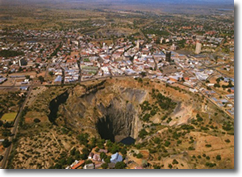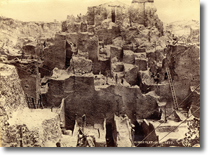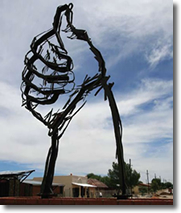 Kimberley, the capital of the Northern Cape, is also often called the Diamond Capital of the World. Without the frenzied pace of larger cities, this city offers the lessons learned from the past, the convenience of modern facilities and the promise of a bright future, as its people rally round to ensure its growth and prosperity.
Kimberley, the capital of the Northern Cape, is also often called the Diamond Capital of the World. Without the frenzied pace of larger cities, this city offers the lessons learned from the past, the convenience of modern facilities and the promise of a bright future, as its people rally round to ensure its growth and prosperity.
It is an enigmatic city, its character difficult to pin down. Modern goods are sold from antiquated buildings and hyper-modern structures reach towards the sky in a curious mix of old and new, modern and historic. Long-time inhabitants exchange friendly greetings on the city streets as they walk past historic buildings to enter a fast food restaurant on the corner.
The history of Kimberley tells of success and vast wealth, but also of heartbreak and lost hopes. While the fortunes of some improved to such an extent that they went on to finance the development of
the Witwatersrand gold mines, many came to the diamond fields with stars in their eyes and found only tears. However, the tragedies did not stop new hopefuls from arrivingevery day, each new arrival contributing to the growth of a city.
 Development started in 1871, when diamond deposits were found on the farm Vooruitzig, which belonged to the De Beers brothers. By 1872, a mining town, home to more than 50,000 people, had grown where once only the springbok roamed.
Development started in 1871, when diamond deposits were found on the farm Vooruitzig, which belonged to the De Beers brothers. By 1872, a mining town, home to more than 50,000 people, had grown where once only the springbok roamed.
At first called New Rush, the name of the town was changed to Kimberley in 1873, in honour of the Earl of Kimberley, the British Secretary of State for the colonies at the time. Within a short space of time, the haphazardly planned tent town mushroomed into a city of substance and was the first in the Southern Hemisphere to install electric streetlights and the first in South Africa to have a stock exchange. At one time, Kimberley also had the dubious honour of being the town with the most pubs per person, in the world.

Galeshewe, the satellite township that adjoins Kimberley, was originally built under the apartheid laws to house the areas African population and is still largely populated by African people. The townships existence dates from 1871 and for many years it was known as Number Two Location, until 1952 when it was named after Chief Galeshewe of the Batlhaping tribe. He was an important figure to the local African population and spent many years in jail after he rebelled against the Cape Colony Government several times to protect his people.
Related Link:
nike